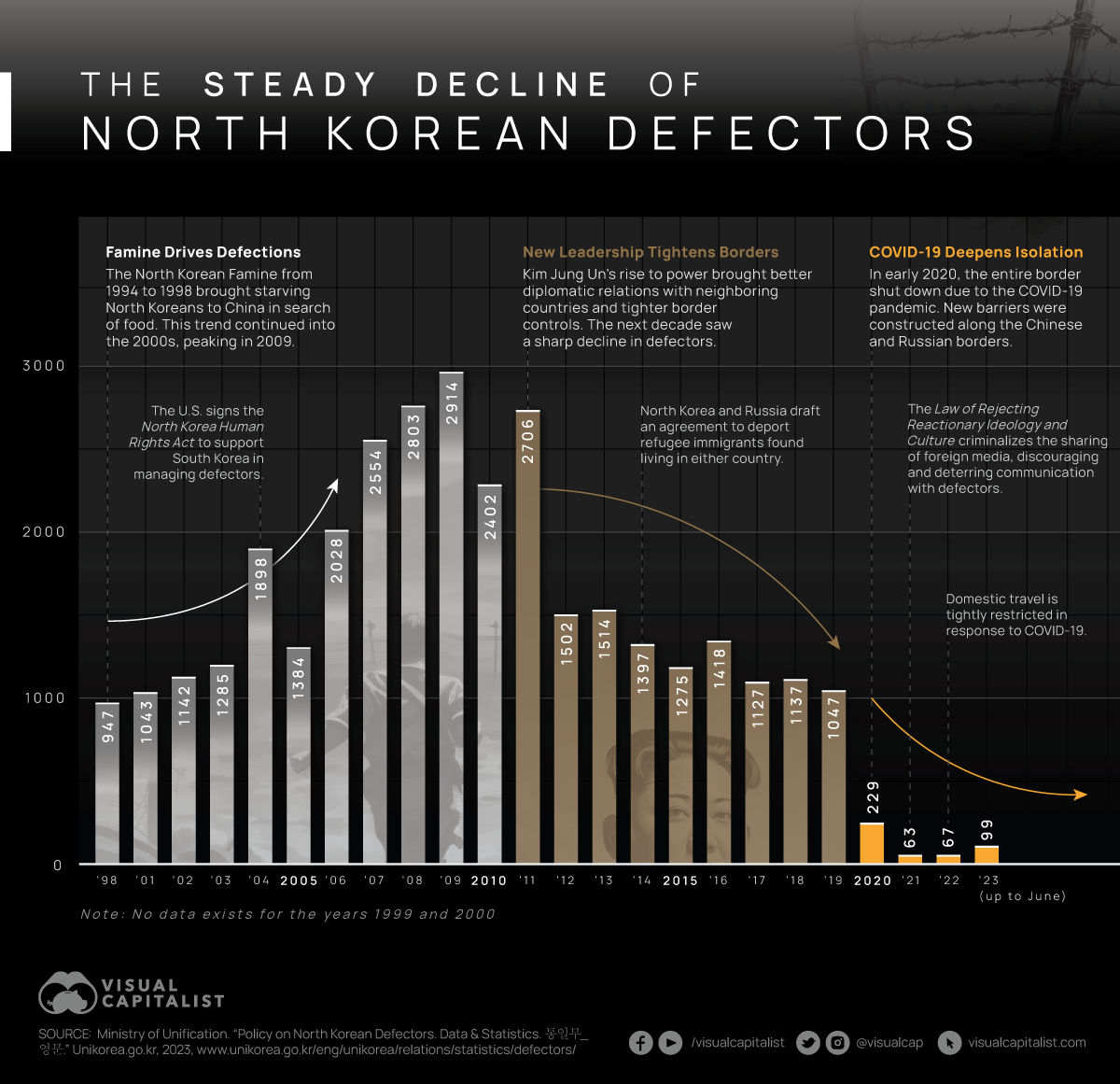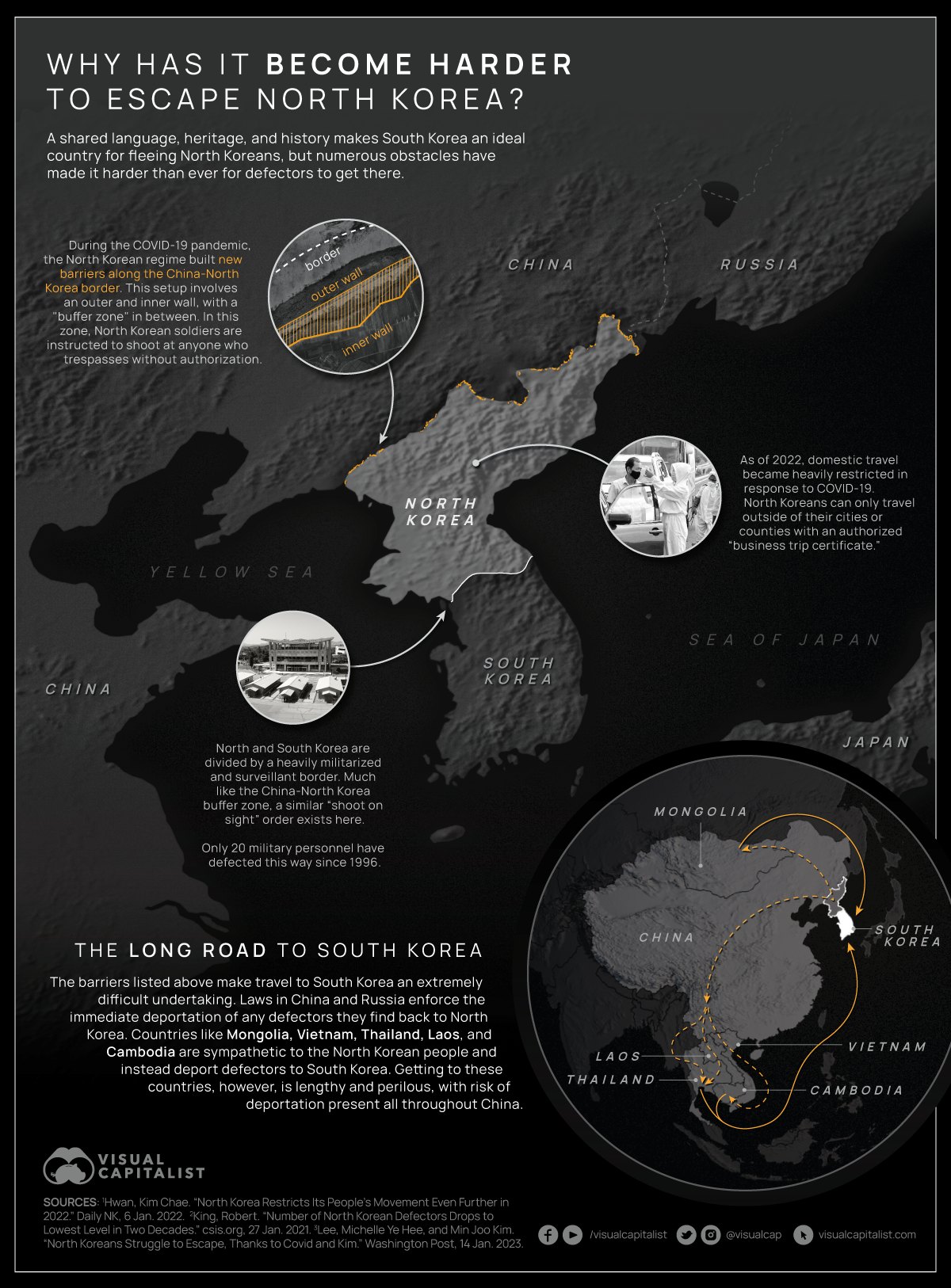
Why Are the Number of North Korean Defectors Decreasing?
North Korea, formally known as the Democratic People’s Republic of Korea, is a totalitarian dictatorship with extremely limited freedoms and rights reported for its citizens.
Due to the country’s tight controls on borders and information, people that want to leave the country often have to physically escape and are known as defectors.
These visuals use data from the South Korea’s Ministry of Reunification to track the number of North Korean defectors who make it to South Korea each year, as well as international reporting to explain the dwindling numbers.
North Korean Defectors from 1998–2023
The table below shows the amount of successful North Korean defectors that arrived in South Korea from 1998 through to June of 2023. Note that there was no data available for 1999 and 2000.
| Year | North KoreanDefectors |
|---|---|
| 1998 | 947 |
| 1999 | N/A |
| 2000 | N/A |
| 2001 | 1,043 |
| 2002 | 1,142 |
| 2003 | 1,285 |
| 2004 | 1,898 |
| 2005 | 1,384 |
| 2006 | 2,028 |
| 2007 | 2,554 |
| 2008 | 2,803 |
| 2009 | 2,914 |
| 2010 | 2,402 |
| 2011 | 2,706 |
| 2012 | 1,502 |
| 2013 | 1,514 |
| 2014 | 1,397 |
| 2015 | 1,275 |
| 2016 | 1,418 |
| 2017 | 1,127 |
| 2018 | 1,137 |
| 2019 | 1,047 |
| 2020 | 229 |
| 2021 | 63 |
| 2022 | 67 |
| 2023 (as of June) | 99 |
From the 1990s to 2010, we can see the amount of North Korean defectors steadily climbing to a peak of 2,914 people in 2009 alone.
More residents looked to escape the country after suffering through the North Korean Famine of 1994 to 1998—with death estimates ranging from 240,000 to 3,500,000—as well as the country’s increasingly bleak economic conditions following the collapse of the neighboring Soviet Union.
We can also see the immediate impact of Kim Jung Un’s rise to power since 2012, with successful defections immediately dropping by 1,204 year-over-year and declining consistently over the next decade. Stronger border controls were one factor, as were improved relations with China and agreements with Russia on sending escapees back to North Korea.
And North Korea has seen defections drop further, from thousands to low hundreds, since 2020. Following the COVID-19 pandemic, the country shut down all borders, created new barriers, and significantly limited internal travel.
Mapping Escape Routes from North Korea

Click here to see a larger version of the graphic above.
Since they can’t cross the heavily surveilled and militarized border to South Korea, the Korean Demilitarized Zone, North Korean defectors have to travel through Russia or China to get to friendly countries in order to seek asylum.
For most defectors, these include reaching Mongolia to the north or Cambodia, Laos, Thailand, and Vietnam to the south, which all work with the South Korean government on reunification.
There are also defectors that try to stay in Russia or China. In 2009, a global refugee survey found there were 11,000 North Korean refugees hiding in China close to the North Korea border alone, not accounting for the rest of the country.
Others are able to seek refuge in other countries and eventually attain citizenship. In 2022, the UNHCR registered 260 refugees and 127 asylees from North Korea, with Germany hosting the most at 96 and the U.S. second at 70.
The post Charted: The Number of North Korean Defectors (1998-2023) appeared first on Visual Capitalist.